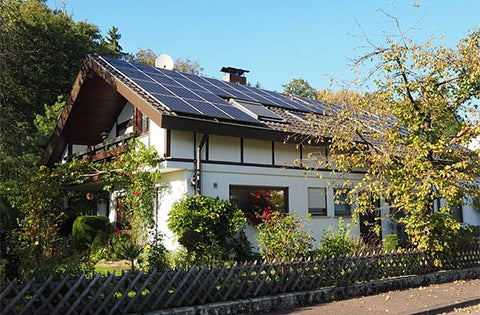Have you ever heard about bifacial solar panel? In the solar market, another significant product development is rising. Bifacial solar panels that can absorb sunlight from both the front and rear end are an intriguing new solar alternative for some types of solar systems.
The traditional solar panels are also known as mono facial panels that can absorb light from only one surface, thus wasting the light energy that does not get absorbed. On the other hand, the bifacial solar panels are different from the conventional panels as they come with solar cells equipped on both sides. This mechanism helps the solar panel absorb the solar energy from both sides that enhance energy consumption. In this article, we will primarily focus on bifacial solar panels.
What is a bifacial cell?
Initially, bifacial solar cells were concerned with extreme latitudes and snowprone regions where solar energy is present as diffused sunlight that has bounced off the ground and surrounding objects or in BIPV applications. However, advanced bifacial solar cells allow simultaneous and efficient light conversion from both sides into electricity by employing an upgraded surface design.
Bifacial cells usually use a front surface design that is comparable to that of industry-standard screen-printed solar cells, with the main variation being the structure of the back surface contact. A ' finger ' grid allows sunlight to pass through the back instead of using a reflective aluminum contact to cover the full-back surface.

Traditional solar panels have several disadvantages that bifacial solar modules do not. A bifacial panel can generate power from both sides, boosting overall electricity production. They are frequently more resilient since both sides areUV resistant, and when the bifacial solar panel is structurally sound, the risk of potentially induced deterioration (PID) gets diminished. When more electricity is available, the cost of the balance of the system (BOS) gets reduced as well.
Benefits of bifacial solar panels
Bifacial solar panels may represent the industry's future. There are tons of benefits of bifacial panels over the traditional ones. Some of them are listed below:
Efficiency
Fewer bifacial solar panels can reliably generate the same degree of solar power as a typical mono-facialsolar array. Being 11-12% more efficient, bifacial panels can reduce the LCOE(Levelized Cost of Energy) by increasing the total energy generation of similar-sized projects. Besides higher performance, bifacial panels also overcome the limitation of high temperatures. Their glass composition channels lower working temperatures without the heat-absorbing aluminum backing of mono-facial panels.
Durability
The tempered glass strengthens the light-absorbing capacity of the panel and provides a sounding edge. Owners are also entitled to extended warranties given Potential-induced Degradation (PID) concerns for bifacial solar panels by both sides being UV resistant. In addition to the durable manufacturing, the panels are also equipped for providing a reliable shield in case of any bad weather conditions.
Design
Not tampering with the aesthetics of the facade is an inherent benefit due to its sleek design that passes sunlight directly. Moreover, the design of the bifacial panels aids in putting them into service for various purposes such as awnings, barriers, or pergolas, depending on the location.
Accommodativeness
Bifacial solar panels' performance is independent of the angle of their installation as they can even be fixed at 90°. Furthermore, space utilization is also updated since fewer panels are now fulfilling the energy requirements.
Cost-effective
Determined by a study, bifacial panels on solar trackers decrease power costs by 16%. Additionally, the glass utilized is 20-30% cheaper than the transparent sheets employed in mono-facial panels. Bifacial panel owners also benefit from a proportional decrease in labor and maintenance costs. Since more power can be generated from bifacial modules in a smaller array footprint, BOS equipment, and related costs are also diminished.
Limitations of bifacial solar panels
Even though there are innumerable benefits of bifacial solar panels, there are certain drawbacks as well. Let's look at some of the disadvantages of a bifacial solar panel.
Bulky
Contrary to the mono-facial panels, bifacial solar panels embody a fair share of weight that might hinder adjustments and demand care. Examining the installation space would be sensible since the modules are approximately 15-20 pounds above the conventional panels. The consumer would be wise to have a professional solar engineer assess the roof's structural integrity before installation for reliable judgment.
Suitability
The panel's design restricts its installation locations, and the models function best with a reflective surface. Their double-sided cells reduce compatibility with rooftops. However, you can still use bifacial panels effectively on a flatter roof by managing the angles. Bifacial solar panels need open space and a reflective surface underneath to achieve optimal energy outputs.
Cost
Even with higher total upfront costs, the added cost of the panels is less than 10%, as per the NREL research. To weigh the financial merits of single-sided versus bifacial modules, the effective leveled cost of electricity should be applied as the deciding metric aside from the rupee-per-peak-watt cost of respective modules.

While maintenance costs remain equivalent across all modules, bifacial panels also maximize the use of the generated photovoltaic electricity for amplified bell curve distribution of generated power. Considering the performance, it would be safe to know that the benefits significantly outweigh the drawbacks as their increased efficiency allows a quicker return on their investment.
Monofacial VS Bifacial solar panels
Unlike Bifacial Panels, Monofacial Panels collect light through cells on only one side and are placed in racks parallel to a surface. The price difference ranges from $0.01 to $0.10 per watt for large-scale projects between bifacial and monofacial. Results and studies have testified that bifacial modules can generate approximately 10-20% additional power over monofacial panels. Bifacial Solar Panels also deliver a longer and durable lifecycle as compared to Monofacial Solar Panels.
Showcasing advanced performance by maximizing electricity output levels through clean energy produced while the sun is rising and setting, bifacial solar panels promise an innovative way of energy consumption. Before opting for this clean and sustainable energy source, evaluate your roof, installation space, budget, and energy consumption patterns to make a suitable investment.
Without the need for excessive electricity transmission upgrades, bifacial panels allow community solar farms to be built close to where customers need them. Explore an enhanced range of high-grade modules at SOLARPARTS collection for your next solar energy appliance addition.
Twitter: Solarparts Instagram: Solarparts
Tumblr: Solarparts Pinterest: Solarparts
Facebook: Shenzhen Solarparts Inc
Email address: Philip@isolarparts.com
Homepage: www.isolarparts.com



